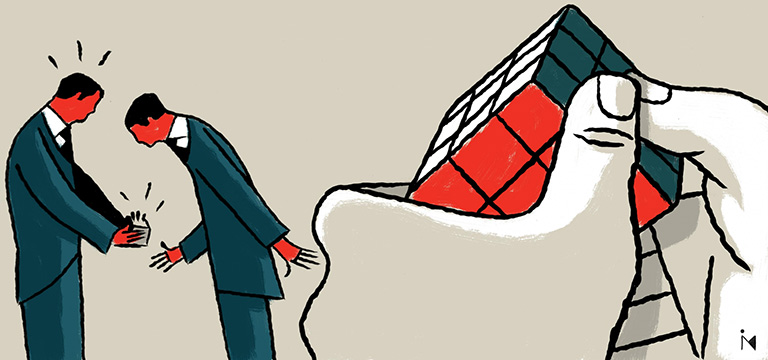Success in life does not arrive by coincidence, but is rather the result of lots of work, discipline, being consistent with our beliefs, our attitude in the face of difficulties and luck, to a lesser degree. But luck is something we have to go looking for.
In the field of investment, reality is not much different. To obtain an average return of 15% over some 20 years, we need a work method that keeps us thinking clearly and acting accordingly no matter whether the market tells us that Telefónica is worth more than 30€ and we think it is worth 9€, while we watch the shares jump to 30€.
At Cobas AM we have a work method called Value Investing, perfected over many years. Although. like any other, it is not infallible, it helps us to get it right in 90% of our investments.
We will surely make mistakes again, tripping over another Pescanova, or not seeing another Inditex coming. In spite of that, however, we expect to continue getting a good night’s rest, which is what matters. In other words, ensuring that participants are at ease and preserve their equity and providing a reasonable degree of returns. The only method so far that has demonstrated this capacity is Value Investing. Others may make it big with Bitcoins, but I doubt they can do so repeatedly.
What does Value Investing consist of at Cobas?
Now that it is very much in vogue, we should explain what it means to us. In a few words, it consists in buying at bargain prices, as easy as that. It is a matter of applying common sense to investing in the stock market, like we do in other aspects of our lives. For example, think about all the time we spend analysing the best option when we want to buy a car or a home. This is exactly what we have to do when it comes to investment.
However, we can’t lose sight of a VERY important point, which is that we have to love it, feel passionately about it, believe it and apply it when the market is against us. If we don’t believe it, sooner or later we will end up following the market. That reminds me of the film Pretty Woman, when Richard Gere takes Julia Roberts to the opera and says that “people’s reaction to opera the first time they see it is extreme, they either love it or they hate it. If they love it, they will always love it, if they don’t they may learn to appreciate it, but it will never become part of their soul.” Value Investing is somewhat similar; or you understand it and like it right away, or it becomes very difficult to understand and make it your own afterwards.
Without going into too much detail, Value Investing consists in a correct assessment of a company; this requires answering a series of questions to find out more about the company (investment ideas), and Value Investing gives the guidelines needed to answer those questions.
Investment ideas and where they come from
Our sources of ideas are very diverse, we might say that this is the most artisan part of our work. They may be competitors of companies already included in our portfolio, sources we find each day in the press, by attending conferences, etc. However, the source or origin of ideas where we find real safe bargains (ten-baggers, as they are referred to by Peter Lynch) appear in times of crisis. That is why they are not to be feared. Regardless, we have to do our homework before they appear, which they surely will.
During a crisis, the prices of all companies fall, whether good or bad, and we have to take advantage of that. During the year 2008-2009, I remember having seen many companies at bargain prices: BMW preference shares were quoted at 11€ (at 72€ today), Ferrovial at 3€ (at 18€ today), Exor at 5€ (at 50€ today).
Does the company we are studying do good business?
Obviously, an analyst who only covers ten companies in the same industry and has done so for ten years or longer knows more than we do; that is why we use their knowledge to find out what is important in a company or industry. We don’t need to know everything about a company. All we have to do is separate what is important from what is not and that is where we add value.
We have to be able to explain in our own words what the company does, find their competitors, how their market share has evolved in the last ten years and why, if it has any competitive advantage and what kind (briefly, a competitive advantage is what allows you to charge a higher price than the competition for a product or service for an extended period of time).
To simplify, let’s just say that all this work can be summarised by “scoring” the business with a ratio. Return on Capital Employed (ROCE) is nothing more than comparing how much money a company needs to invest to start a business versus how much money it makes; the higher this is, the better the business. Take for example The pharmaceutical industry usually has high ROCEs – sometimes over 50% – because they are protected by a patent. On the other hand, commodity companies without protection usually have ROCEs near 10% or even lower.
How good is the company’s management team?
The first thing we look at is whether the individuals who are betting their money along with ours are executives or owners. Then we review how they have managed the company in the past: if they have been able to rise above a crisis/difficulty, how they assign capital, if they like to grow for the sake of growing by buying at high prices, what their incentives are, etc. And finally, we speak with the competition, customers, ex-employees, etc. to get a better view from inside the industry. We may find a good business at a good price, but if we don’t trust the management team, it is better to forget investing in a company and skip to the next investment idea.
Why is it cheap if it is such a good business?
This is usually because the company or industry is going through temporary difficulties that have resulted in losing “favour” with the market. In many cases, it is simply because the majority of the market does not invest long-term and wants short-term results, which is something we don’t do. If we trust that the business is good, that the management team has the necessary experience to turn the company around in a temporary situation and that there are no structural changes (disruptions), we are willing to invest. For example, this is what we are doing this year with the Arytza company.
How do we assess a company properly?
It isn’t a matter of learning an interesting story, but of doing the numbers. At Cobas we do our homework and draw up our own model for each of the companies we analyse. The model has to be both simple and complete, so a “birds-eye view” will be enough to ask ourselves why the results are what they are and not different. We “flee” from highly complex models or those that use formulas that are not simply: adding, subtracting, multiplying and dividing. If my daughter Alexandra, aged 16, does not understand my model, that’s not good.
Our model consists of a basic calculation of how much it makes and how much it spends to reach a normalized profit to which we apply PE ratio 15x (the historic mean of the stock exchange in the last 200 years). Our models DO NOT use financial mathematics (WACC, Beta, etc.) that Alexandra and many professionals are incapable of understanding.
In sum, normalizing profit comes down to not extrapolating a good or bad situation of a company forever. If there have been no structural changes in the company or industry, logic tells us that profits will tend to return to the mean of the last economic cycle.
As an example, in 2006 many analysts in Spain thought that there would be 500,000 homes built each year forever and made their assessments on that premise, but now we know what happened two years later.
When to sell?
As investors, if we are not disciplined about this, two very different things may happen: The first possibility is to retain poor investments during a long time, hoping for the company’s situation to improve; unfortunately, in most cases they don’t. The second is selling good investments too soon.
It may seem obvious, but the first reason for selling is that we have made a mistake. A mistake in evaluation, or a change in the essentials of the company because the entry barriers were not as high as we thought, in which case we have to recognize the mistake and accept the losses as soon as possible.
However, it is equally important to know when to sell and when NOT to sell. One of the first things I learnt is that if I buy a share today and it falls by 50% tomorrow and I am not happy about it, I should never have bought it in the first place.
If the company announces that the next quarter or year, their results will be “sluggish” due to a particular difficulty (that is not structural) and shares drop 20%-30%, we have to take advantage of the situation, instead of panicking and selling. On the contrary, we have to buy more, like we have done this year at Cobas with regard to Técnicas Reunidas.
Do we have the appropriate personality to apply this method?
If we answer these questions correctly and assess the company properly, but we don’t have the appropriate personality, we have a problem. We have to stay calm at all times, be patient and withstand the criticisms without letting them affect us so we don’t follow the lead of the market (avoiding herd behaviour). At the same time, though, we have to be humble and recognize our mistakes. If we don’t have that type of personality, we become more vulnerable and will end up yielding to market pressure.
In sum, Value Investing is a work method that has been perfected over many years. If it is applied by a person or team of individuals with certain characteristics, the long-term yield in stock market investment will be dependable
“Be fearful when others are greedy and greedy when others are fearful”. Warren Buffett.
Did you find this useful?
- |








